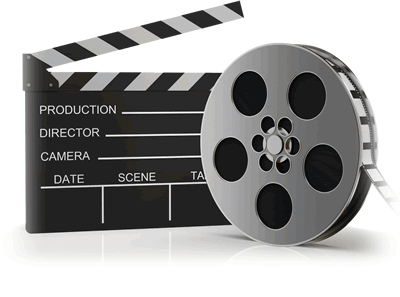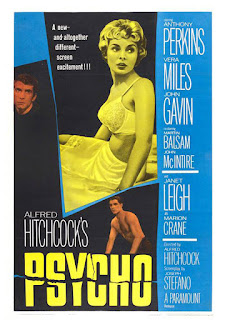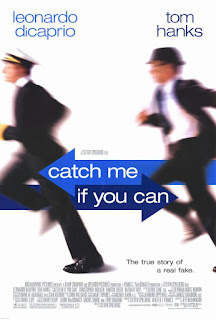To a true movie fan,
answering the question “What is your favorite movie” can feel like a Herculean
feat. Responding to a single question may not be as tough a situation as vanquishing
the Hydra, but I have always found myself stymied in the face of it. So, in an
effort to finally come up with a list, I took a few hours – it really did take
two hours – and came up with a list of what (currently) are my Top 25 Favorite
Movies.
Those 25 films are listed
below accompanied by a brief overview of my thoughts. I should acknowledge now
that this list is destined to be very fluid and, chances are, this list will be
different this time next year. Or perhaps next month. Maybe even tomorrow. In addition,
I have chosen to organize this list in chronological order based on each film’s
date-of-release.
Before plunging into the
list proper, I have decided to include five Honorable Mentions: films which
just missed the cut. These films include: Anatomy
of a Murder (1959), Batman
(1989), Cape Fear (1991), The King’s Speech (2010), and The Hateful Eight (2015). Each are
brilliant films which I love. So, without further ado, let’s jump right in…
*
1. The
Adventures of Robin Hood (1938) – The
Golden Age of Hollywood produced many epics, but none have the same sense of
fun and adventure that this, the definitive version of the Robin Hood myth, has.
Errol Flynn, Olivia de Havilland, and Basil Rathbone lead a stellar cast in
this Technicolor spectacle which boasts the finest sword fight ever put to
film.
2. 12 Angry Men
(1957) – Another bona fide classic which truly needs no
introduction, 12 Angry Men is truly
the greatest character study ever put to film. Henry Fonda is enthralling as
the forgiving juror, but Lee J. Cobb steals the show. This one is considered
one of the finest court room dramas for a reason.
3. Witness for
the Prosecution (1958) – Billy Wilder’s
adaptation of Agatha Christie’s classic courtroom whodunit stage-play is an
exciting and engaging watch. Few things are as they seem in this
masterfully-acted thriller starring Charles Laughton, Tyrone Power, Marlene
Dietrich, and Laughton’s real-life wife, Elsa Lanchester at her comedic best.
4. North by
Northwest (1959) – Hitchcock’s
epic cross-country adventure is a darkly comedic thriller featuring many
edge-of-your-seat set-pieces. Cary Grant evades the police by train, runs for
his life from a deadly crop duster, and scales the faces of Mount Rushmore with
Eva Marie Saint at his side. James Mason and Martin Landau are at their creepy
best as the sophisticated villains.
5. Psycho (1960)
– Alfred Hitchcock’s
follow-up to North by Northwest couldn’t
be more different than predecessor, emerging as a dark, unnerving horror film.
The infamous shower scene has, of course, become a cultural icon on its own,
but the entire film is steeped in atmosphere, generated in no small part by
Bernard Hermann’s haunting string score.
6. The Birds (1963)
– The closest thing that
the Master of Suspense made to a monster movie, The Birds subverts its genre conventions in favor of Hitchcock’s
signature suspense. The scene set at the playground is truly one of the
greatest set-pieces in Hitchcock’s filmography.
7. Wait Until
Dark (1967) – Audrey Hepburn isn’t
associated with thrillers, but the star has rarely been better on screen than
here, playing a blind woman terrorized by a gang of ruthless criminals. The
entirety of Wait Until Dark is a
brilliant exercise in suspense, but it’s the film’s finale – more-or-less
creating the jump scare – which brings the whole film to a horrifying fever
pitch and leaves me – and audiences everywhere – no longer on the edge of their
seats, but on the floor.
8. What’s Up Doc
(1972) – This, an open love letter
by Peter Bogdanovich to the screwball comedies of the ‘30s and ‘40s, is one of
the funniest movies I have ever seen. From its delightful farce in Act One, to
comedic car chase in Act Two, the Barbra Streisand and Ryan O’Neal-starring comedy
still feels as fresh and as fun as it did when it first premiered.
9. The Sting (1973)
– The heist movie has become an
institution in film today and, though The
Sting does not purport to be the first heist film, few movies which share
its genre can say that they told their story as charmingly. Paul Newman and
Robert Redford simply scintillate as the wizened con and his protégé, and Robert
Shaw is incredibly watchable (as always) as the gangster who their out to con.
There are too many great moments to outline, but I have always found the poker
game on the train to be a particular delight.
10. The Exorcist
(1973) – Hands down one the
scariest films ever made, William Friedkin’s no-holds-barred exercise in making
audiences scream is, at times, liable to make your skin crawl. Its horrific set
pieces have gone down in cinema history, but the film’s foreboding atmosphere is
simply palpable. Once seen, The Exorcist
is not easily forgotten.
11. Young
Frankenstein (1974) – Like What’s Up Doc, Mel Brooks’ send-up of
classic horror has aged well. Perhaps, even better. I defy anyone to think of a
comedy which is more quotable than this one. One need only look to the classic
exchange regarding “Abby someone…Abby normal” to prove my point. Gene Wilder,
Marty Feldman, Madeline Kahn, and Peter Boyle (to name a few) effortlessly
provide laugh after laugh after laugh…
12. Jaws (1975)
– Steven Spielberg’s movie
about a shark is so much more than a foreboding dorsal fin. It’s the story of
an unlikely partnership formed by Roy Scheider’s police chief, Robert Shaw’s
grizzled fisherman, and Richard Dreyfuss’ shark expert. It’s yet another
brilliant example of suspenseful filmmaking, and character-driven storytelling.
The famous U.S.S. Indianapolis speech
is a chilling highlight. Launching the summer blockbuster, even after so many
years, Jaws still makes us afraid to
go in the water.

13. Halloween
(1978) – I have already written at
length about the merits of John Carpenter’s genre-defining slasher, so I will
be brief in an effort not to repeat myself too much. Halloween still has the ability to scare: Michael Myers having,
rightfully, become one of the most spine-chilling figures of horror cinema.
Donald Pleasence as the determined doctor and Jamie Lee Curtis as the equally
determined babysitter lead the cast in this cheaply-made but profoundly
effective thriller.
14. Planes,
Trains, and Automobiles (1987) – It’s
become a tradition to watch this movie every Thanksgiving, and John Hughes’
comedy warrants its revisiting. Steve Martin and John Candy have impeccable on-screen
chemistry and line-after-line and scene-after-scene is memorable and quotable.
Even after all these years, Martin’s tirade at the car rental agency can make
me laugh until I cry.
15. Die Hard (1988)
– It’s easy to call Die Hard the greatest action film ever
made, but why? Perhaps it’s the incredible tension generated by having one man
take on a group of terrorists in one building. Perhaps, it’s those terrorists:
a group of villains led by Alan Rickman’s perversely likable Hans Gruber. For
my money, though, it’s Bruce Willis’ John McClane: a hardened NYPD officer who
finds himself in over his head very quickly. Willis’ McClane is such an identifiable
hero, constantly wisecracking, and fun to watch, that we cannot help but cheer
him on from the very start.

16. GoodFellas (1990)
– As you begin to watch
Martin Scorsese’s hands-down masterpiece, you can understand why you might want
always want to be a gangster. GoodFellas
is engaging on both a storytelling and technical level: its long-take through
the Copacabana is rightfully lauded, as are the performances by Ray Liotta,
Robert De Niro, and, of course, Joe Pesci. But, as GoodFellas progresses, you become witness to a fascinating
fall-from-grace all accompanied by what has to be the finest soundtrack ever
assembled for one film. Honestly, I can take or leave The Godfather, but GoodFellas
will capture my attention each and every time.

17. The Silence
of the Lambs (1991) – Based on the
Thomas Harris thriller, Silence of the
Lambs was not the first film to feature Dr. Hannibal Lector, but it is
certainly the most famous. Despite having only about 16 minutes of screen-time,
Anthony Hopkins is simply mesmerizing. Jodi Foster also positively shines as
the heroic Clarice Starling and her story of rising to prominence in a
male-dominated industry is a poignant one to be found amidst the horror and
thrills, but adds weight to the pulpy storyline. Lector’s escape is also one of
the best scenes of suspense ever filmed.

18. JFK (1991)
– As I have written
elsewhere, Oliver Stone’s conspiracy thriller ceases to be a movie at one point
and becomes an experience. The film is so well acted, and edited that the
combination of news footage, recreation, and original material can become
dizzying. Running more than three hours, JFK
can feel daunting, but it is just as epic. The scene between Kevin Costner and
Donald Sutherland’s unnamed informant is one of the most riveting pieces of
film I have ever watched.
19. A Few Good
Men (1992) – Aaron Sorkin’s
courtroom drama features his usual hallmarks of wise-cracking characters and
incredibly memorable dialogue. Elevated by performances from Tom Cruise, Demi
Moore, and, of course, Jack Nicholson, A
Few Good Men manages to pose fascinating questions as well. When it’s all
said and done, one has to wonder if you can handle the truth.
20. Pulp Fiction
(1994) – Quentin Tarantino’s masterpiece
is an engaging, quirky, and off-kilter crime thriller. John Travolta, Samuel L.
Jackson, and Uma Thurman shine as they deliver Tarantino’s brilliant dialogue. Pulp Fiction is such a unique and
one-of-a-kind film that even Tarantino’s other films cannot compare to it.
21. The
Shawshank Redemption (1994) – Based
on the short story by Stephen King, this behind-bars character study is the
highest-rated film on IMDb and boasts critical praise on all fronts, so there
is little new that I think I can add aside from saying that I too – like so
many others – am always moved with each new viewing. And, it’s twist-ending of
sorts, is truly brilliant. How it wasn’t spoiled for me, I’ll never know.
22. The Usual
Suspects (1995) – Speaking of twist
endings…I don’t want to say too much other than this one floored me too. The Usual Suspects is surely one of the
most original crime thrillers ever put to film and its central performances are
hard to match. The verbal game of cat-and-mouse between Kevin Spacey and Chazz
Palminteri, which makes up the heart of the film, is truly an exhilarating
watch.
23. Catch Me If
You Can (2002) – In Steven Spielberg’s
hands, this stranger-than-fiction but real-life account starring Leonardo
DiCaprio and Tom Hanks warrants revisiting again and again. Spielberg manages
to balance the frivolity of the story with its darker undertones, and the
performances from the leads – including Christopher Walken, Martin Sheen, and
Amy Adams – make their characters feel real and engaging. Catch Me If You Can is one of those movies which has the honor
of being worthy of a re-watch almost as soon as it’s over.
24. Inglorious
Basterds (2009) – Tarantino’s epic
World War II film is just as much a movie about movies as it is about war.
Despite its bleak subject matter – and grisly violence – Inglorious Basterds remains a fun, likable film. Christoph Waltz
is the obvious highlight, but Brad Pitt’s ludicrous Nazi hunter is a comic
highlight, and Mélanie Laurent’s vengeful cinema-owner is a fascinating study
in obsession.
25. The Social
Network (2010) – A brilliant
collaboration between director David Fincher and Aaron Sorkin, the story of the
creation of Facebook is both a treat for the eyes and the ears. Sorkin’s
dialogue and Fincher’s aesthetic complement each other beautifully, and Jesse
Eisenburg delivers a powerhouse performance as the cold Zuckerberg. It’s a film
worthy of being called a modern classic.
*
That is that, then.
Generating a list of even 25 was not easy at all. I couldn’t imagine trying to
cherry-pick these, narrowing the list down to 10…or heaven forbid, five…or one!
I have included a few statistics
which I found of interest below.
Including
Honorable Mentions:
1 film
prior to 1950, 4 films from the ‘50s, 3 films from the ‘60s, 6 films from the
‘70s, 3 films from the ‘80s, 8 films from the ‘90s, 5 films post 2000
3 films by
Alfred Hitchcock, 3 films by Quentin Tarantino, 2 films by Steven Spielberg,
and 2 films by Martin Scorsese
4
court-room dramas, 6 horror films, 4 comedies, 5 movies based on real-life
events
Average
run-time: 2 hours 6 minutes














































